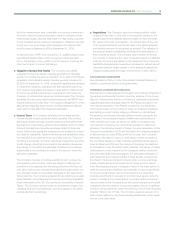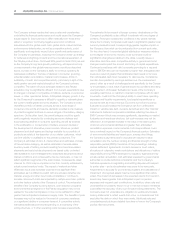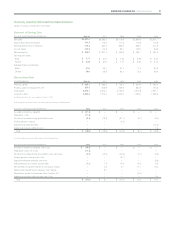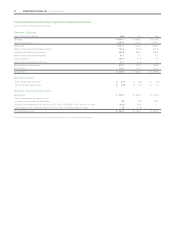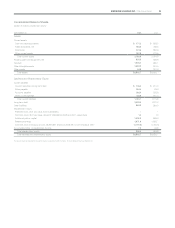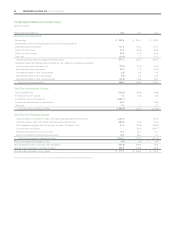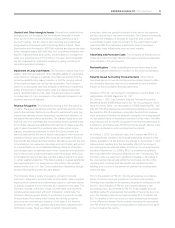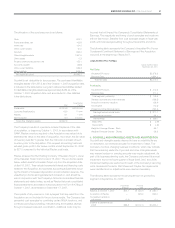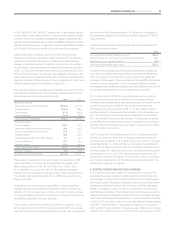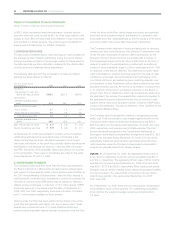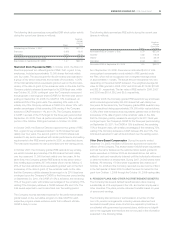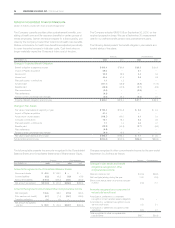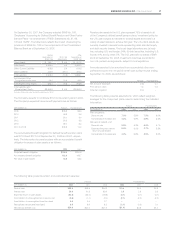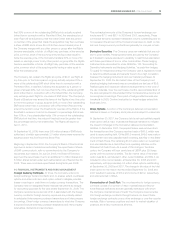Energizer 2008 Annual Report Download - page 31
Download and view the complete annual report
Please find page 31 of the 2008 Energizer annual report below. You can navigate through the pages in the report by either clicking on the pages listed below, or by using the keyword search tool below to find specific information within the annual report.
ENERGIZER HOLDINGS, INC. 2008 Annual Report 29
Goodwill and Other Intangible Assets Goodwill and indefinite-lived
intangibles are not amortized, but are evaluated annually for impair-
ment as part of the Company’s annual business planning cycle in
the fourth quarter. The fair value of each reporting unit is estimated
using valuation techniques such as Earnings Before Interest, Taxes,
Depreciation and Amortization (EBITDA) multiples and discounted cash
flows. Intangible assets with finite lives, and a remaining weighted aver-
age life of approximately seven years, are amortized on a straight-line
basis over expected lives of 18 months to 15 years. Such intangibles
are also evaluated for impairment including on-going monitoring of
potential impairment indicators.
Impairment of Long-Lived Assets The Company reviews long-lived
assets, other than goodwill and other intangible assets for impairment,
when events or changes in business circumstances indicate that the
remaining useful life may warrant revision or that the carrying amount
of the long-lived asset may not be fully recoverable. The Company
performs undiscounted cash flow analyses to determine if impairment
exists. If impairment is determined to exist, any related impairment
loss is calculated based on fair value. Impairment losses on assets
to be disposed of, if any, are based on the estimated proceeds to be
received, less cost of disposal.
Revenue Recognition The Company’s revenue is from the sale of its
products. Revenue is recognized when title, ownership and risk of loss
pass to the customer. Discounts are offered to customers for early pay-
ment and an estimate of such discounts is recorded as a reduction of
net sales in the same period as the sale. Our standard sales terms are
final and returns or exchanges are not permitted unless a special excep-
tion is made; reserves are established and recorded in cases where the
right of return does exist for a particular sale. Under certain circum-
stances, we authorize customers to return Sun Care products that
have not been sold by the end of the sun care season, which is normal
practice in the sun care industry. We record sun care sales at the time
the products are shipped and title transfers. Simultaneously with the time
of the shipment, we reduce sun care sales and cost of sales, and record
an accrued liability on our Consolidated Balance Sheet for anticipated
returns based upon an estimated return level. Customers are required to
pay for the sun care product purchased under the required terms. Due
to the seasonal nature of sun care, we offer a limited extension of terms
to certain qualified customers. This limited extension requires substantial
cash payments prior to or during the sun care season. We generally
receive returns of our U.S. Sun Care products from September through
January following the summer sun care season.
The Company offers a variety of programs, primarily to its retail
customers, designed to promote sales of its products. Such programs
require periodic payments and allowances based on estimated results
of specific programs and are recorded as a reduction to net sales. The
Company accrues, at the time of sale, the estimated total payments
and allowances associated with each transaction. Additionally, the
Company offers programs directly to consumers to promote the sale
of its products. Promotions which reduce the ultimate consumer
sale prices are recorded as a reduction of net sales at the time the
promotional offer is made, generally using estimated redemption and
participation levels. Taxes we collect on behalf of governmental
authorities, which are generally included in the price to the customer,
are also recorded as a reduction of net sales. The Company continually
assesses the adequacy of accruals for customer and consumer
promotional program costs not yet paid. To the extent total program
payments differ from estimates, adjustments may be necessary.
Historically, these adjustments have not been material.
Advertising and Promotion Costs The Company advertises and pro-
motes its products through national and regional media and expenses
such activities in the year incurred.
Reclassifications Certain reclassifications have been made to the
prior year financial statements to conform to the current presentation.
Recently Issued Accounting Pronouncements Other than as
described below, no new accounting pronouncement issued or effec-
tive during the fiscal year has had or is expected to have a material
impact on the consolidated financial statements.
Adoption of FIN 48, “Accounting for Uncertainty in Income Taxes – An
Interpretation of FASB Statement No. 109”
On October 1, 2007, the Company adopted Financial Accounting
Standards Board (FASB) Interpretation No. 48, “Accounting for Uncer-
tainty in Income Taxes – an Interpretation of FASB Statement No. 109”
(FIN 48). FIN 48 addresses the accounting and disclosure of uncertain
tax positions. FIN 48 prescribes a recognition threshold and measure-
ment attributes for the financial statement recognition and measurement
of a tax position taken or expected to be taken in a tax return. The differ-
ence between the tax benefit recognized in the financial statements for
a position in accordance with FIN 48 and the tax benefit claimed in the
tax return is referred to as an unrecognized tax benefit.
At October 1, 2007, the adoption date, the Company had $34.5 of
unrecognized tax benefits in the financial statements exclusive of the
Playtex acquisition. Of this amount, the change to the October 1, 2007
balance sheet resulting from the cumulative effect of the change in
accounting principle was immaterial. Included in the unrecognized tax
benefits at September 30, 2008 is $43.5 of uncertain tax positions
that would affect the Company’s effective tax rate, if recognized. The
Company does not expect any significant increases or decreases to
the unrecognized tax benefits within the next twelve months of this
reporting date. Unrecognized tax benefits are classified as other
liabilities (non-current) to the extent that payment is not anticipated
within one year.
Prior to the adoption of FIN 48, only interest expense on underpay-
ments of income taxes was included in the income tax provision.
Penalties were classified as an operating expense in arriving at pre-tax
income. Upon adoption of FIN 48, the Company elected a new
accounting policy, as permitted by FIN 48, to also classify accrued
penalties related to unrecognized tax benefits in the income tax provi-
sion. The Company has accrued approximately $5.8 of interest and
$0.7 in penalties in the income tax provision. Interest was computed
on the difference between the tax position recognized in accordance
with FIN 48 and the amount previously taken or expected to be taken
in the Company’s tax returns.


